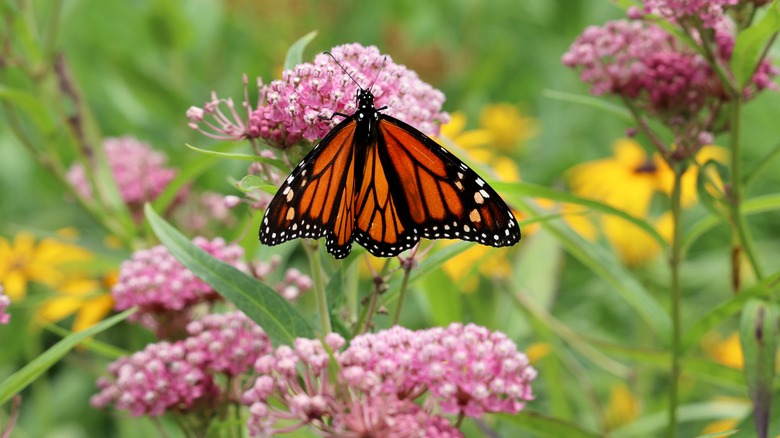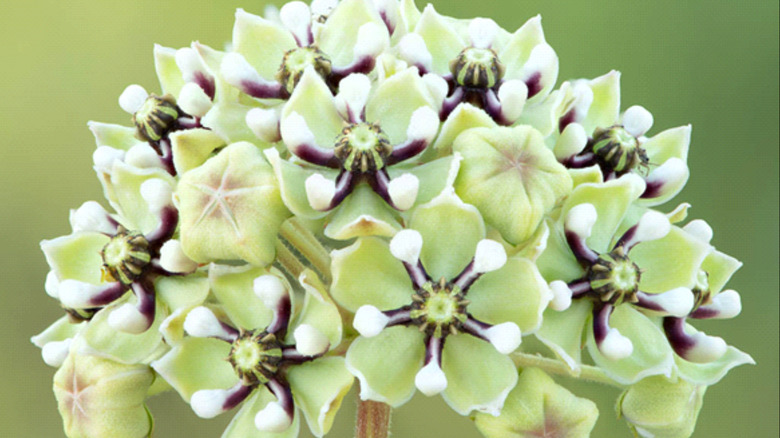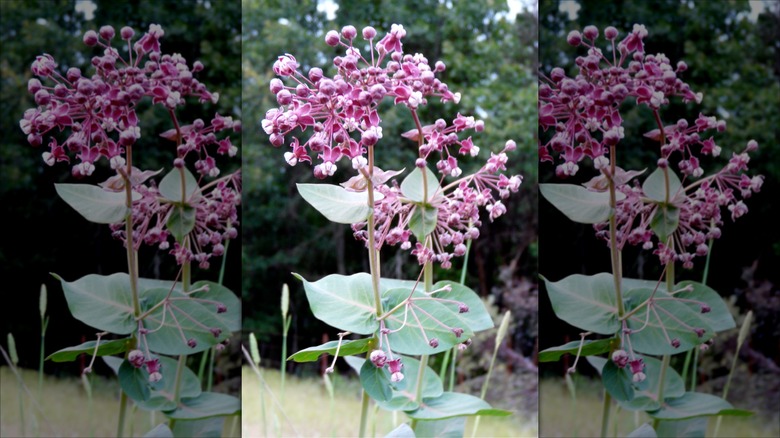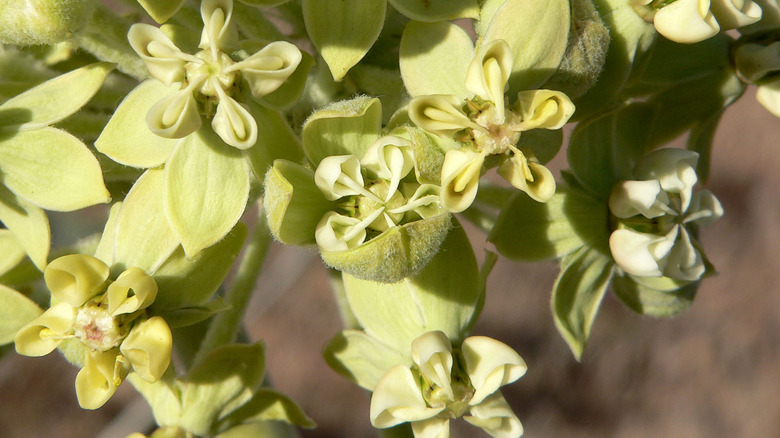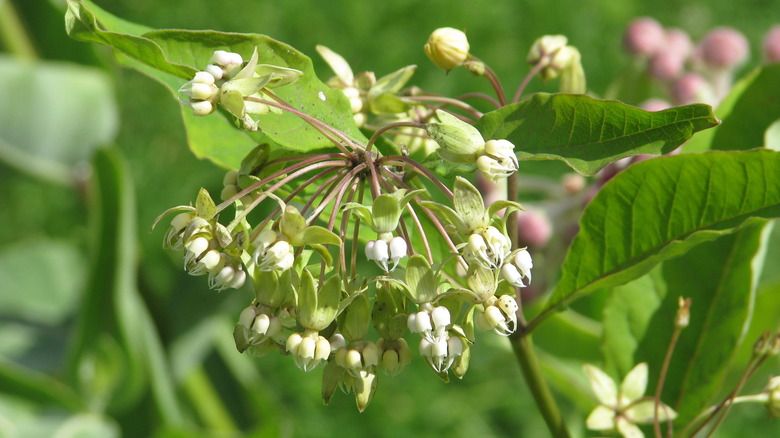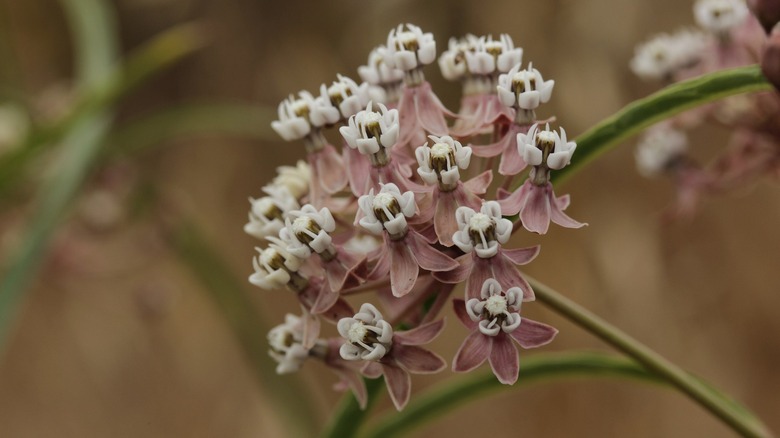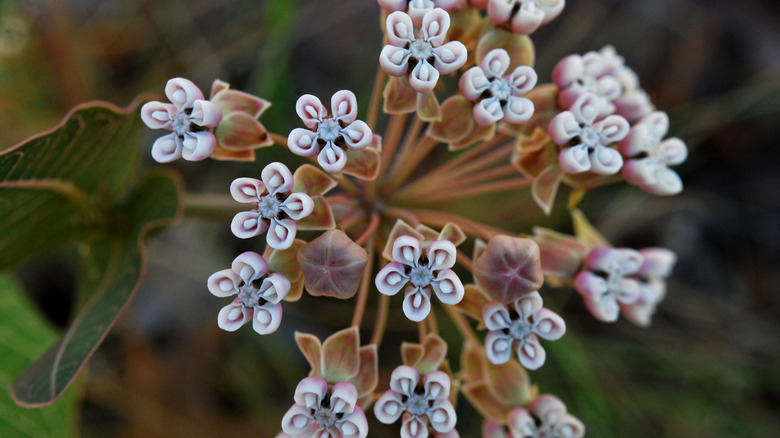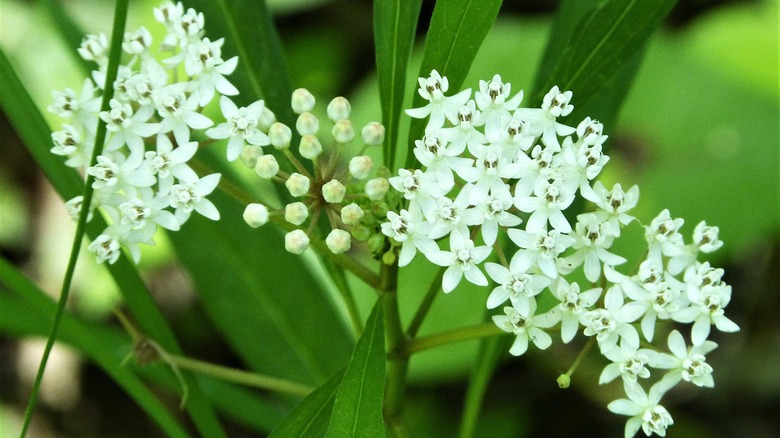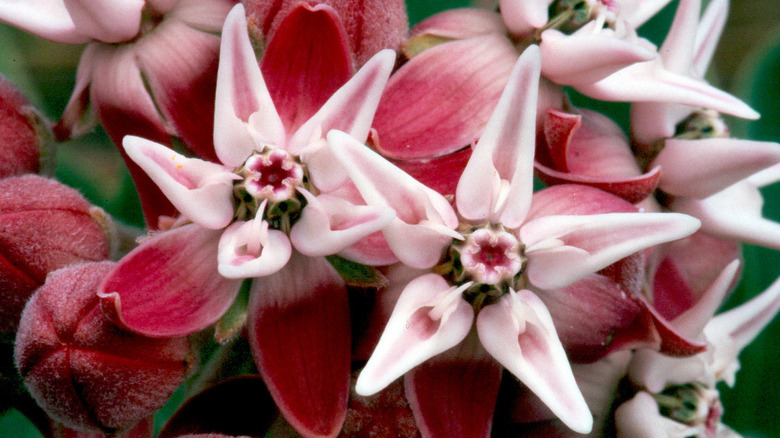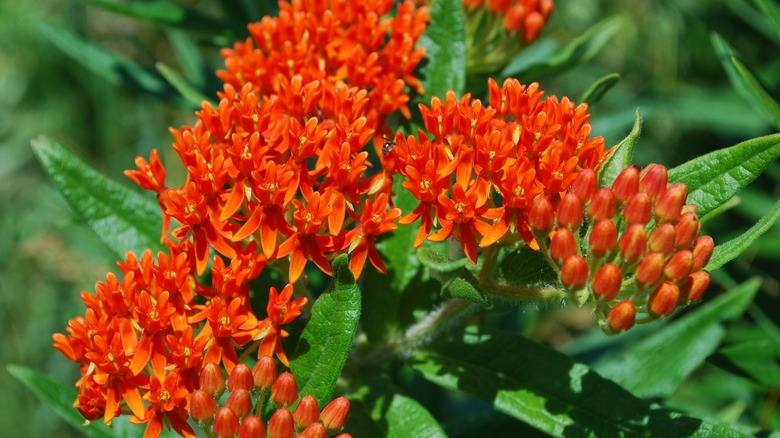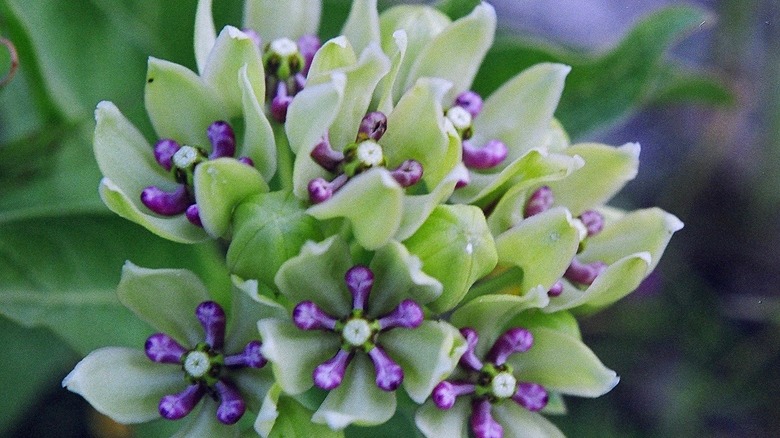10 Varieties Of Milkweed Butterflies Absolutely Love
Spotting a butterfly on your property would likely put a smile on your face, not to mention that they would also benefit your garden, since they're pollinators. Fortunately, there are various ways to attract butterflies to your yard, including growing milkweed. If you have milkweed in your yard, you may even notice monarch butterfly caterpillars on it, thanks to the fact that the plant is home to the tiny creatures. It's also something that provides monarchs with a tasty meal.
Of course, monarchs aren't the only butterflies who are attracted by milkweed. You might end up with various butterflies including the American copper, great spangled fritillary, eastern tiger swallowtail, edward's hairstreak (which has a hilarious name), pipevine swallowtail, and red admiral. There are also a variety of milkweed plants that you can grow to bring these beautiful creatures to your outdoor space. Each will offer your yard with a specific look and prefers certain conditions. For instance, some like to be planted in areas that are sunny and dry, while others enjoy spots that get nice and humid. These details can help you decide which kind — or multiple kinds — of milkweed you would like to grow to attract butterflies. However, keep in mind that all types of milkweed are toxic (per NCPC), so be cautious when planting if you have pets and children.
1. Antelope horns (Asclepias asperula)
Antelope horns are a variety of milkweed that goes by a range of other names. For instance, you might know it as spider antelope horns or spider milkweed. Thriving in USDA growing zones 7 to 9, this milkweed plant grows naturally in many of America's western states. Preferring a fair share of sunshine and soil that's not too soggy, it can grow to be 2 feet tall and will attract butterflies like monarchs and queen butterflies, which look similar and will leave behind their larvae.
[Image by Auracas via Wikimedia Commons | Cropped and scaled | Creative Commons Attribution-Share Alike 4.0 International License]
2. Heartleaf milkweed (Asclepias cordifolia)
Heartleaf milkweed gives you a hint of its appearance in its name. Indeed having heart-shaped leaves, they're also a shade between blue and green while boasting purple areas. Growing up to 1 or 2 feet tall, they should be easy for butterflies to find in your yard. If you live in zones 7 to 10, then you might want to grow heartleaf milkweed, which will bring monarch and queen butterflies to your property. Despite the sweet name, this milkweed can grow in soil that has a substantial amount of rocks and gravel.
[Image by First Light via English Wikipedia | Cropped and scaled, mirror image |Creative Commons Attribution-Share Alike 3.0 Unported License]
3. Desert milkweed (Asclepias erosa)
Desert milkweed is another variety that gives away a detail about itself in its name. Growing in the desert and eager to soak up as much sunshine as possible, it's an ideal choice if your home is in zones 4 to 10. Producing gorgeous greenery that can stretch up to 5 feet tall, it also blooms flowers that can be a shade of cream, light yellow, or greenish yellow. You'll surely enjoy seeing these blooms covered in butterflies who stop by your yard to visit your patches of milkweed.
[Image by Stan Shebs via Wikimedia Commons | Cropped and scaled | Creative Commons Attribution-Share Alike 3.0 Unported License and GNU Free Documentation License]
4. Tall milkweed (Asclepias exaltata)
Although it would be funny if tall milkweed was a short and stubby plant, it indeed stretches pretty high, though it's interestingly not as tall as other milkweed varieties. It can grow up to 4 feet tall, while others may grow taller. Butterflies will appreciate the white and lavender blooms that will grow on each plant. This is a variety of milkweed that you'll want to grow in zones 4 to 7, which will result in plants that produce flowers from May to August — a fabulous time to welcome butterflies into your yard.
[Image by Peganum via Flickr | Cropped and scaled | Creative Commons Attribution-Share Alike 2.0 Generic License]
5. Narrowleaf milkweed (Asclepias fascicularis)
Narrowleaf milkweed grows relatively pointy leaves that will add a unique look to your outdoor space while attracting butterflies. Growing well in USDA zones 6 to 10, they tend to bloom between June and September, which will give you plenty of time to enjoy their 1 to 3-foot height, pink and white flowers, and the butterflies that are attracted to it. Along with butterflies, this milkweed will also bring beneficial bees to your property.
[Image by Björn S... via Flickr | Cropped and scaled | Creative Commons Attribution-Share Alike 2.0 Generic License]
6. Sandhill milkweed (Asclepias humistrata)
Sandhill milkweed is something that you might be familiar with if you live in the southeast region of the United States. You might also know it as pinewoods milkweed, and the plant thrives in zones 8a through 9b. Reaching up to 3 feet high, this milkweed is topped with flowers that are pink or purple. Butterflies that stop by in March may be spotted on your sandhill milkweed as well as any that flitter into your yard until June. It's aptly named, as it appreciates a dry, sandy spot and lots of sun.
[Image by ggallice via Flickr | Cropped and scaled| Creative Commons Attribution 2.0 Generic License]
7. Aquatic milkweed (Asclepias perennis)
Aquatic milkweed is also known as white swamp milkweed which, we're sure we can all agree, isn't as nice as the first moniker. While the name might make you think that this milkweed exists in full water, it is a wetland plant that prefers a relatively soggy spot. A variety of milkweed you should consider if you live in zones 8a to 10b, it will certainly attract the butterflies that you're looking to find in your yard.
[Image by gailhampshire via Flickr | Cropped and scaled | Creative Commons Attribution 2.0 Generic License]
8. Showy milkweed (Asclepias speciosa)
Another plant that attracts bees along with butterflies, showy milkweed will certainly catch your attention as well. A contender if you live in zones 3 to 9, it can grow to be 6 feet high although tends to be around 3 feet if given a spot in well-drained soil and lots of sunshine. It can also stand up to droughts after a few years of established growth. Blooming in the summer, you and your visiting pollinators will be able to enjoy the pink and white flowers during that time.
[Image by Bureau of Land Management via Flickr | Cropped and scaled | Creative Commons Attribution 2.0 Generic License]
9. Butterfly milkweed (Asclepias tuberosa)
Butterfly milkweed is also called orange milkweed, which isn't surprising thanks to the vibrant flowers, although some also burst into life with stunning yellow blooms. These tropical-looking plants love to live in zones 3 to 9 and flower from May right through to September, which is when they can grow to be 1 to 3 feet high. Also given the similar name butterfly weed, it's hard to imagine anyone wanting to get rid of this plant along with typical weeds due to the fact that they attract butterflies.
[Image by wackybadger via Flickr| Cropped and scaled | Creative Commons Attribution-Share Alike 2.0 Generic License]
10. Green milkweed (Asclepias viridis)
Green milkweed, which is also known as green-flowered milkweed, gets its name — or names — from the fact that it has flowers with green-tinged petals. Found in USDA zones 5 to 9, butterflies will find them in your yard while they bloom from May to July. Although this plant prefers to get full sun and soil that isn't too wet, it can also be tolerant to droughts. When conditions are ideal, green milkweed will grow to be anywhere from 1½ to 2½ feet high.
[Image by sonnia hill via Flickr | Cropped and scaled | Creative Commons Attribution 2.0 Generic License]
